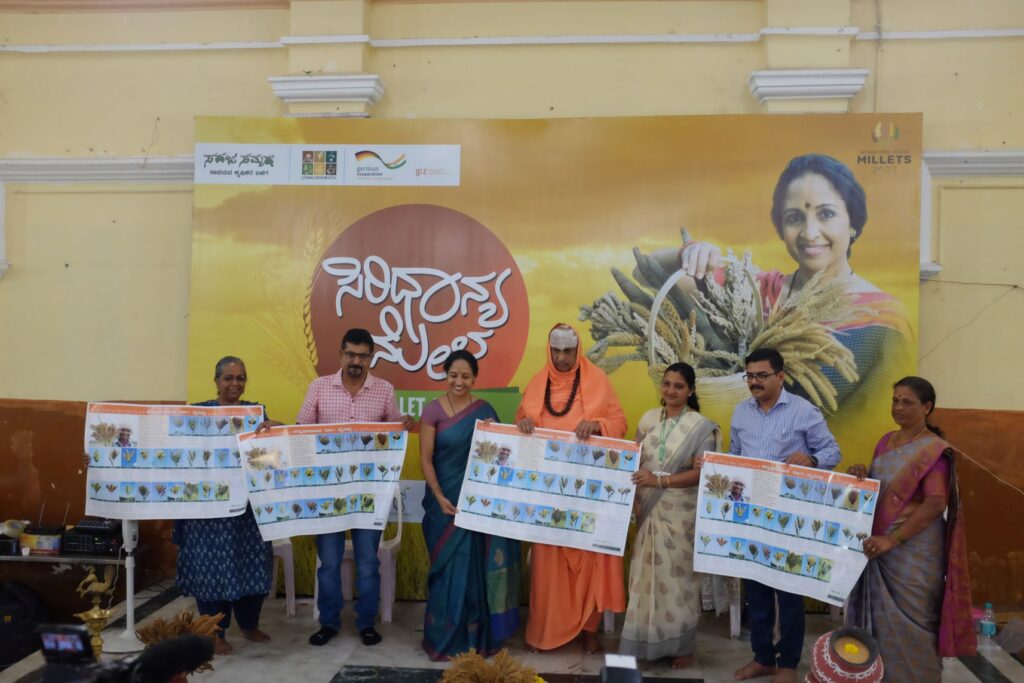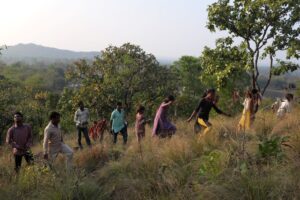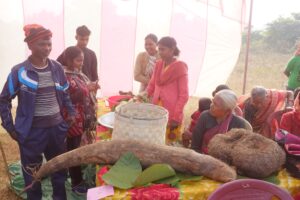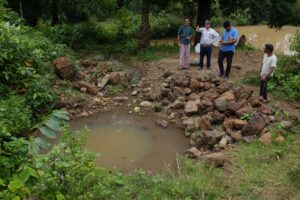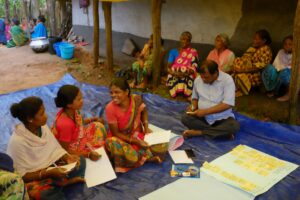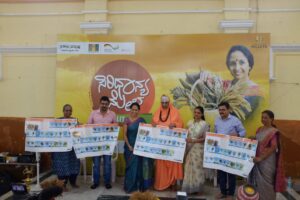26th to 30th August, 2023, Mysuru, Karnataka
A joint Using Diversity (UD) Network and Habitat Rights workshop was organised in Mysuru from 26th to 30th August 2023 with the first 2 days involving a Millet Mela jointly organised by UD partner Sahaja Samrudha and the Using Diversity Network. The event involved over 70 participants from all the different project areas. Partners, Fellows and Community Representatives from the different project areas put up a display of a rich diversity of crops, seeds and wild and uncultivated crops at the Millet Mela.
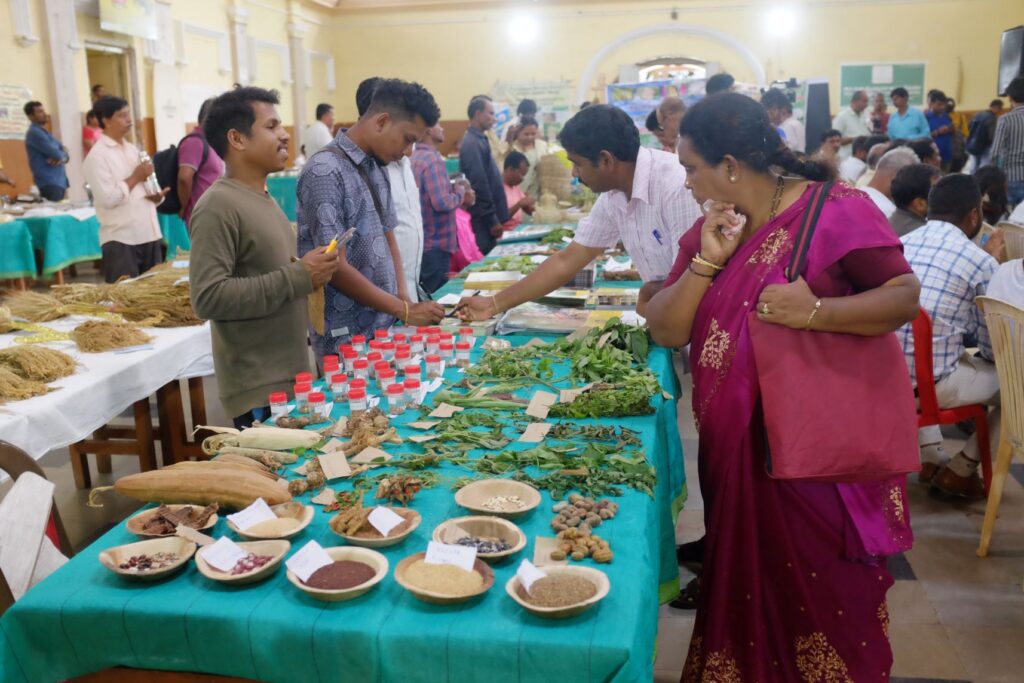
The 3 days after the Millet mela involved sharing of experiences, updates, learnings and challenges from all the different project areas; Guest talks on different issues like implementation of Forest Rights Acts with a focus on Habitat Rights, Ecological and organic agricultural practices, and shifting cultivation; planning and brainstorming sessions to develop plans and strategies for the way ahead; field visits to Sahaja Samrudha and other initiatives dealing sustainable agriculture, millets and seed conservation and propagation.
28th August 2023
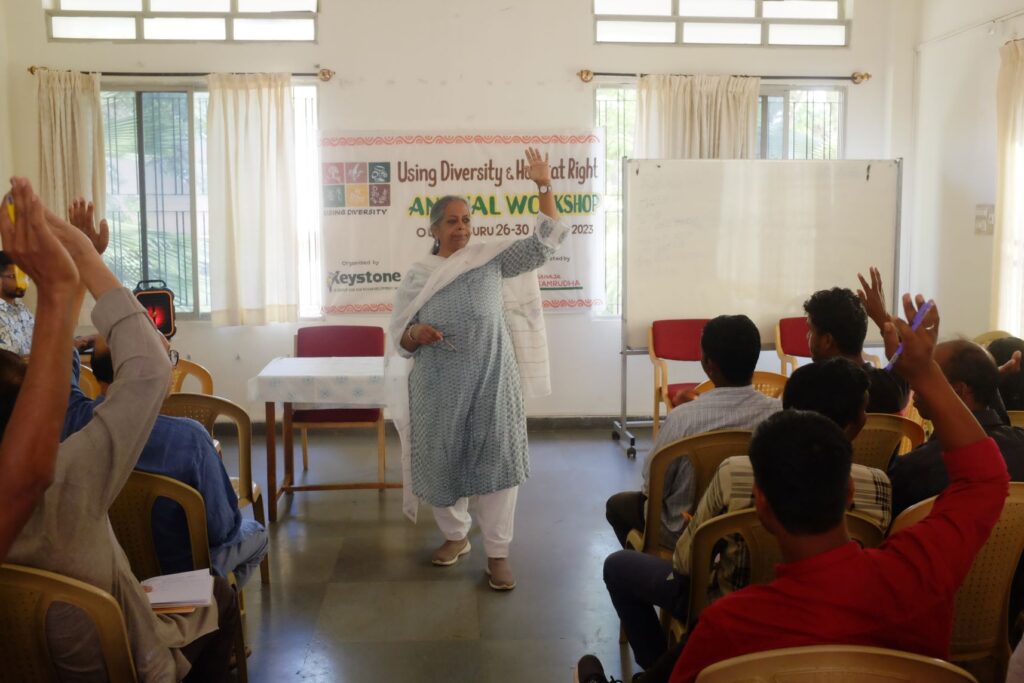
The event commenced with motivational songs by Sidheswar Sardar, Ramgulal, and Laxman (Song on PESA being implemented in MP what it means for the local communities, roles and responsibilities of communities, GS). This was followed by a round of introductions with each participant providing a brief overview of the work they are engaged in.
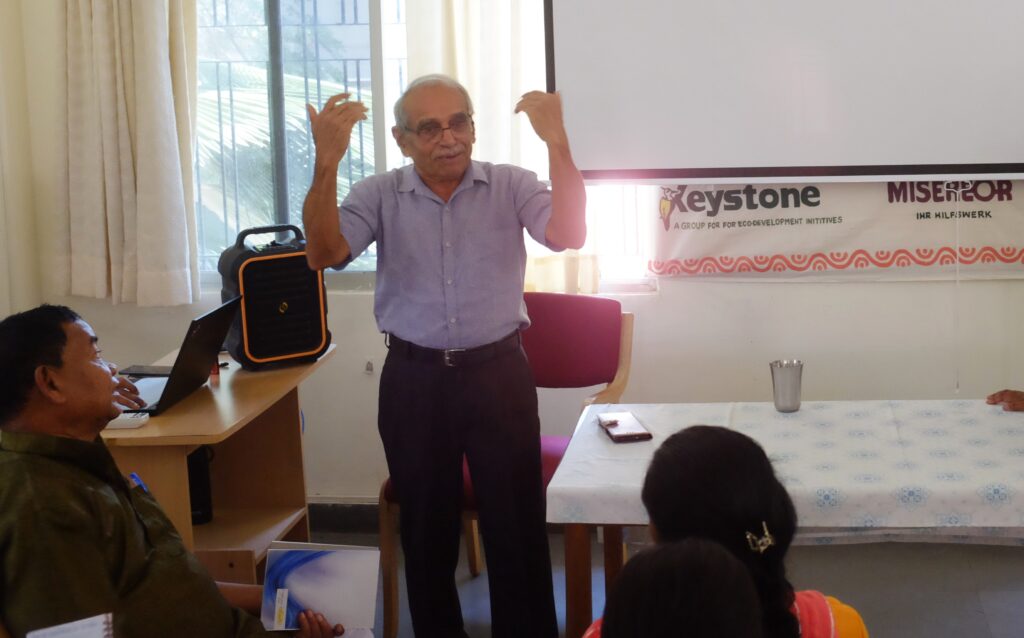
Then we had a special session on Seed Autonomy, Food Sovereignty, Forest Rights and Biodiversity by guest speaker Dr. Nagesh Hegde (Author) who has been working in this field for over 44 years. He resides in Bangalore and teaches journalists about forests, the environment and how to report on these matters. He shared that forests have the right to be the way they are. In New Zealand there is a river that has been given rights to be the way it is and people are fined for violating. We tried to give similar rights to a river in Arunachal Pradesh but were not successful.
He welcomed the participants to Mysuru, one of the cleanest and most beautiful cities of India. 18 things have received GI tag – eg variety of banana pan, Mysore Silk received patent, Rosewood inlay, Mysore Agarbati. Ganjifa Cards. Geographical Identification certificate of max products in Karnataka (42 of which 18 are from Mysore). He talked about GI certification and how it should be claimed for products from areas our participants come from. He then began his presentation by delving into the Columbian Exchange (1500-1610 ) – which saw a lot of natural resources going from from Coloumbia (South America) to Europe, Asia, Africa, and from Europe to South America. He spoke of Darwin’s Theory of Evolution along with diminishing trees / biodiversity. He pointed out that all of humanity (man and its domestic anilmals) weigh more the 6 times the weight of wild mammals. There is a need to protect wild diversity, and this cannot be done by city people, only rural and forest dwelling communities can do this. Corporates in agriculture are using the best varieties from farmers and are earning crores. Some are still spared from their exploitation. There is a need to record your natural and organic diversity at Panchayat level to prevent corporate control of our native diversity. He gave the example of maize in the USA where in 1913 100% of corn was farmer owned but in 2013 – 95% is corporate owned. He talked about how native varieties are making way for corporate promoted varieties like GM cotton which resulted in the loss of 97% of India’s native cotton varieties. Seed is not only for food it is a source of fodder, fiber, fertilizer. Moringa is very popular on a commercial scale with its seeds used for weight loss. Manale seeds for soap and ornaments. Baru seeds – tribal community shared that the seed could be used to make butter, and this also got commercialized.
Protecting seeds is good and above all it is necessary for protecting your sovereignty and independence and not becoming totally dependent on the companies. In Karnataka the farmers are not able to do anything themselves, even getting ground water for which, they used livestock. Farmer has become puppet of corporate.
In Japan the King promotes local paddy and its cultivation to protect native diversity and to ensure they don’t have to depend on imports for food needs. In India there is no such pride. Common farmer in India has lost most of his freedom – seed, water, fodder etc. He also touched upon Seeds of monopoly – dooms day seed vault. Global seed vault with 4-5 companies controlling seeds and associated dangers. Kissinger 1970 “If you control the oil you control the country If you control food you control the population.” We should meet our energy needs ourselves eg through solar and we should control our own seeds. He felt that GM mustard will it be a game changer as it will destroy local varieties. He spoke about the politics of Hybrids whereby corporates take control of seeds, fertilizers, irrigation, pesticides, power. The Politics of GM seeds and Terminator seeds builds on this control.
He talked about protecting and safeguarding genetic wealth like through wild food festivals by tribal people. Local people can safeguard their own natural wealth and should get government to support their efforts. There is a need to teach village children about their forests and natural resources and even more important to teach city children and get them to help protect these resources. Biodiversity has the right to survive and live and in the future this can help protect us.
His session ended with a Question and Answer session in which Rajeev talked about Ratnagiri getting GI tag for Alphonso mango but truth is today more Alphonso is from other areas even Africa. Soumik touched upon the bad condition of our earth, with increasing droughts, arctic melting, world is going to melt. Erosion of traditional knowledge of forests and nature when they go to school, need to take them to the forest and share knowledge between generations. Weed festival – importance of weds. Spread of invasives and role of native species. Ramgulal gave the vote of thanks.
After a break for tea we had Area wise presentations of the Using Diversity project.
- PRERAK – made a presentation about their work with the Kamar and Birhor communities in Gariaband and Korba districts of Chhattisgarh. The PRERAK team comprised Lilehswar (facilitator), Rameshwari and Lukeswari from the Kamar project area and Ramakant and Tiharu from the Birhor project area.
Ramakant, shared that they have been raising a lot of problems of Birhor community at block level – roads, water etc. in Pali and Podi Blocks. They also conducted Awareness program on wild food with children through community members and have been working towards Forest Rights for the Birhor community.
- Lukeswari, shared that they have been having regular meetings to raise and explore various issues being faced by the Kamar community and have been supporting the community to take get these issues address by raising them at the block and district level They are also helping the community take advantage of different government schemes. They have facilitated the distribution and planting of 15,000 saplings, carried out awareness programs on wild food with children and facilitating efforts to ensure Forest Rights for the Kamar people which included training and support to fill IFR and CFR forms and filling of claims.
Lilesh shared details of activities and outputs from the Birhor and Kamar areas –
- Mixed cropping – 10 farmers each from each area received training and support
- Training on organic inputs
- Community Seed Banks – 2 in Korba district and 1 in Mainpur
- 26 varieties of vegetables seeds distributed to 155 hh in each area
- School awareness programs on wild food traditional medicinal plants and cures
- Nursery set up and 15,000 saplings distributed.
- Awareness prog on FRA – CFR and IFR
- Meetings on MGNREGA etc
- State level Beej Mahotsav Dist. Gariaband – Farmers came from different districts. Farmers were happy to see varieties they had not seen before and discussed importance of using organic farming methods with desi seeds and not using chemical inputs.
- Meeting with PVTG communities of Chhattisgarh– Birhor, Kamar, Bhujiya
- Collecting information
Q – Krishna prasad what Mixed Cropping training was given was it on shifting cultivation? Ramakant replied that it involved line sowing using mixed cropping methods.
Q – Sneh – any improvements they noticed in the 3 to 6 years they have been working
Community members from Birhor and Kamar shared
Tiharu – earlier Birhor did not have much agricultural knowledge but through PRERAK that has improved in the 10 villages they work, some changes through Mixed cropping,
Kamar woman – things have improved, they had stopped cultivating ancestors seeds but now they have revived them. Through working with PRERAK – Makka,
Planting – dist saplings during festivals, planted in community places, near fields, Mahua, Kosum, Tori, Bhelwa, Harra, Shikakai, Karanj, Char, Saheja,
Rameshwari – fields , badi. Kusum tree allows the cultivation of lac which they sell for an additional income. Some planting in forest areas.
The presentation ended with a song by Kamar woman.
PBKSKS– The PBKSKS team comprising of Fatik Kumar Hembram (Facilitator), Binod Sabar and Jiban Hansda shared their work and experiences from the Kheria Sabar project area in Bandwan Block, Purulia District, West Bengal.
- Awareness meetings in Sabar hamlets – discussions about Organic and Ecological Agriculture, wild food, seed conservation, Forest rights and challenges faced by the Sabar community.
- Training on seed conservation and cultivation of local crops by Arun Ram at Salidih.
- Distribution of a variety of seeds to Sabar farmers – Finger millet, foxtail millet, pearl millet, little millet, foxtail millet, sorghum, traditional paddy varieties, pulses and legumes like pigeon pea, rice bean, cow pea, velvet bean; and a variety of greens and vegetables.
- Nursery preparation in Jara and Salidih and distribution of saplings of a variety of cultivated and uncultivated trees and plants.
- Farmers like Anil Sabar were even able to sell surplus production in local markets.
- Establishment of 2 Seed Conservation banks at Salidih and Jara.
- Research and awareness on wild and uncultivated foods – mushrooms, greens, wild tubers, fruits and flowers.
- FRA awareness meetings in Sabar hamlets.
- Future plan – expanding nurseries of wild plants, wild plant distribution in other areas, Forest Restoration, Seed Bank Implementation, promotion of Organic Farming Practices and Preservation of Desi Seeds.
- Challenges – Sabar community members don’t open up easily and find it challenging to speak their mind in meetings. Land scarcity – Kheria Sabar Community do not have more than 2 decimal of land. than land of 2 decimal. Sabar Community Protect the forest but other communities cut the tree.
Fatik had shared an image of plastic mulching carried out in his village. Soumik raised concerns about this and pointed out the negative impacts of plastic mulching and advised against use of such methods in the future.
Paryavan Chetna Kendra (PCK) – The PCK team comprising Sidheswar Sardar, Sonaram Bhumij and Mahendra Sabar shared about activities in the Sabar project area in Potka block, East Singhbhum District, Jharkhand
- 10 villages challenges with Sabar interacting with outsiders.
- Have succeeded in winning confidence of Sabar in 5 villages
- Meetings, awareness on wild food and local seeds
- 1 village a Sabar girl doing inter helped a lot in mapping different aspects – where wild food is found, water sources etc. Nagadi and Konarkocha
- Training – they promote traditional mixed cropping – different desi crops, kharia romha, maize, arhar, alongside wild greens.
- People can’t give much time – busy in forest in morning, preparation in afternoon and evening drunk. But still managed to meet in 4 villages. 10-18 people gather but in the course of the meeting the number reduces.
- Discussion on how KG can be effective– fencing etc. issues with water availability. In 3 areas where the govt. made Jal minar and water is overflowing promoting cultivation around that. Wanted brinjal that fruits year around.
- In 3 villages they promoted cultivation around Jal minar with 2 communities.
- Wild food and children – children eat but don’t know names. Took 2 schools to forest for spreading awareness on trees, wild food. One child identified 23 trees another showed where his parents extracted tubers. Got to know different families have designated areas where they collected tubers. Spoke to teachers to include information about the foods that are part of their traditional food systems. 2 Teachers in Butgora agreed to include information about these foods. Some teachers not connected to these foods so not much hope but working well with 2 schools.
- Working on how to safeguard traditional Badi cultivation.
- Wild tubers are reducing in availability issues with over extraction for commercial purposes.
- Due to low rainfall crops are suffering.
- 4 Sabar have patta are doing paddy cultivation others depend on PDS dakiya rice but sell half to middlemen.
- Mohan Sabar (former fellow) became Pradhan of Sabar people.
Paharia – Surja Paharia (Fellow) along with Paharia farmers Leta Paharia and Adiya Paharia shared their experiences from the Paharia project area in Sundar Pahari Block, Godda District, Jharkhand.
- From 2015 they have been working to revive and promote traditional seeds that were disappearing from their areas.
- They did a survey of what was disappearing – Muto (Pearl millet), Petge (Foxtail millet), Batwa (Little millet).
- Started distributing these seeds and now there has been an increase in diversity.
- Distributed seeds to 1101 households across 30 villages 1101 hh.
- Paharia were not understanding imp and benefits of these traditional seeds so they were planting other seeds but now there is increased awareness and also they are cultivating.
- Forest gardens – shade tolerant species turmeric, ginger, taro, – 16 FGs
- Guided fallows – Velvet bean (Kursa) 6 hh
- KG – the Paharia used to plant veg in Kurwa also but didn’t do KG much, 200 families KG seeds given. Awareness meetings on importance of cultivating veg in KG and done lot of work in veg.
- They have been facing challenges with regards to felling of trees for sale of timber which has been resulting in deforestation and degradation of their forests. Middlemen go to individual villages and tempts villagers to cut and sell timber. To combat this, they formed Jungle Bachao Abhiyan Samiti 6 women 10 men and do meeting on forest protection issues. Use mike and spread awareness to protect trees and have given responsibility for this to the Samiti. They talk about preventing forest fires to promote regeneration of trees and forests. Seeing some benefits of protecting forests for 5 years.
- Made nursery of wild forest species – the samiti was given responsibility to collect seeds. Distributed 1000 saplings.
- Get lots of wild food from their forest and through samiti spreading awareness about wild food and awareness with children on wild food.
- Community Seed Bank in 2 areas and they are getting seeds back.
- Group of men and women youth (15 M and 15 F) and working to spread wild food awareness with children.
- Leta – through Forest Garden he gets ginger and turmeric from here and so doesn’t have to depend on market.
- Adiya – no paddy in hills, Maize, Sutru etc. Lost traditional millets, eating chemical food so falling sick, awareness by Keystone Foundation is resulting in revival of seeds. During famine lost a lot of seeds. Again now drought for 2 year so worried that famine conditions might return when they depended on wild tubers and greens without masala and tel.
Nirman shared experiences from the Baiga and Bharia areas in Madhya Pradesh – their team comprised of Naresh Biswas, Laxman from Patalkot, Hiralal and Mayaram from Mandla and Dindori, Laxman from Patalkot and Krishna Prasad Gupta from Jashpur.
Naresh – Baiga 16 jaat ka khana (16 different crops) now only a few from ration shop. Same things shared by Pahari Korwa. Different names for Bewar. Reduced diversity of traditional shifting cultivation motivated them to work to bring back the diversity both in the field and on their plates.
Laxman Patalkot –
- Community Seed Banks – 3 have been set up. Dahiya (shifting cultivation practice of the Bharia people) was on the verge of extinction when work started in 2018. Loss of seeds was one major issue. Through seed banks farmers get local seeds easily and are increasing them.
- KG – reducing dependence and expenses on market veg. Using waste water to cultivate veg in KG.
- Van Kaleva – awareness with children through village elders on wild food. Took teachers and students of 6 schools to forest and also fed them laddu and other foods from traditional crops. Teachers liked the program and wanted Van Kaleva program to be carried out with schools across Patalkot.
Heeralal Dindori –
- Work started with focus on how keeping traditional and wild food at the center they can apply for land and forest rights.
- Biggest challenge was right to land and forests.
- All are forest villages so lot of problems with FD.
- Due to FD restrictions on Bewar it has stopped and seeds had been lost. One farmer had salhar and another had madia (finger millet)so they got these and revived. Also got seeds like pearl millet form other areas like Patalkot and have now revived a lot of seeds.
- Others said that while everyone is trying to develop the Baiga by focusing on traditional crops and food Naresh wishes to keep them primitive. But they did not give up and these efforts have borne fruit and Lahiri Bai’s success is a reflection of these efforts.
- In Dindori there are lots of Sarai / Sal so lots of coup felling which led to reduction in availability of wild food. So, they worked for and got HR for 7 villages. They have worked for restoration of forest in Silpidi village.
- Now for last few months been working in Mandla district. He was born in Kanha his father worked for conservation of Kanha but he and his father were evicted and don’t allow them to enter. He plans to work for rights of Baiga who were evicted from these areas and look and HR for them. For 60-70 yrs in Mandla traditional seeds have disappeared and only paddy is cultivated. So, want to work for promotion of traditional seeds and promoting planting of traditional trees and plants instead of teak which is of use only to FD.
- Beej mela every year in all areas celebrating traditional foods and also draw attention of administration to Forest Rights issues an implementation of FRA with focus of HR
- Bewar song – Bhoot Baiga.
- Naresh Biswas – to KSF Genome award for Lahari Bai. Aware of the challenges. Issues with Syenzenta and taking seeds from community. Need to work on how to deal with such corporates and these issues will be faced wherever we are conserving seeds. Need for capacity building of CSB committees. 2-3 day workshop to analyse threats and possible strategies to combat them and not only focus on organisations conducting activities. How to spread awareness especially about some strategies to combat threats and challenges.
Durgesh Anuppur –
- Khad Mela – 3 years and this is working as a platform to promote FRA
- Bewar – traditional seeds had disappeared but now they have been revived.
- Forest Department promotes species of value to it.
- In one village they have promoted planting of 13 traditional tree species and a lot have survived.
- The Khad Mela has helped connect and work with groups and spread awareness about forest rights with all stakeholders including government representatives.
- Collector came for last year’s Khad Mela and that helped win people’s confidence.
Krishna Gupta –
- Program on Ahal (traditional shifting cultivation practice of the Pahari Korwa people) – which had disappeared. They did not have seeds. He got seeds from other partners and promoted its cultivation.
- Promoting planting of trees in forests that will help them get wild food.
- Documentation of dried wild food.
Western Ghats
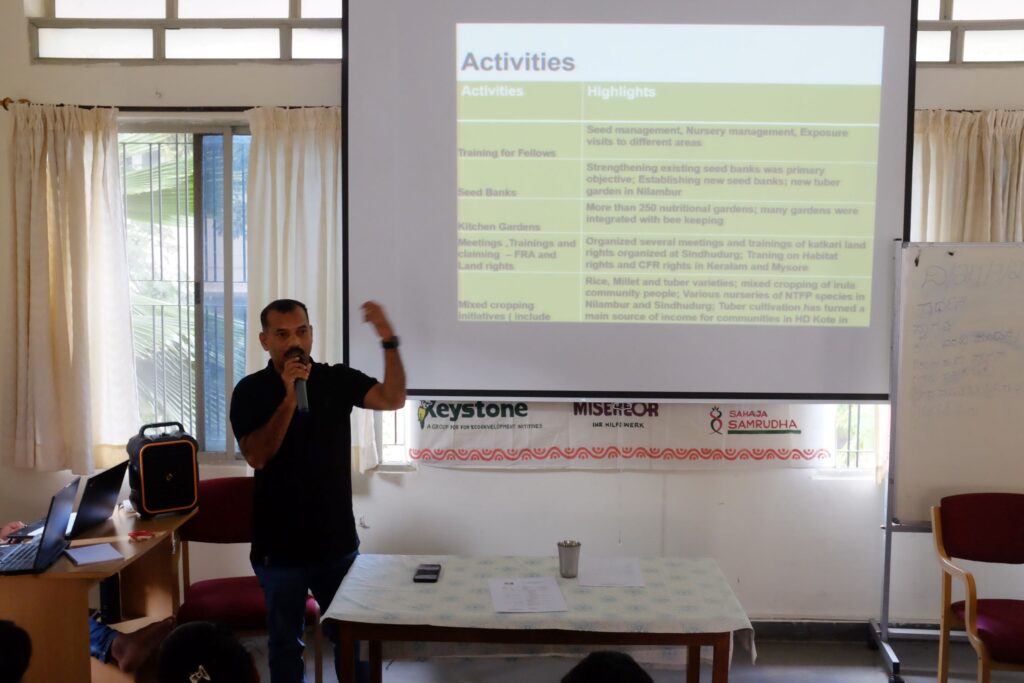
Ramu
Irula and Pania – Tamil Nadu and Kerala; Katkari – Maharashtra
Sunil – Direct beneficiaries Pania and Kattunaikan and Indirect – Chollanaikan, Muduvan, Aranadan.
- Collection of forests produce a primary source of livelihood for these communities.
- Set up 100 + KG
- Community managed nursery.
- FRA Interventions –
- Forest food basket – a WhatsApp group of local community members in Nilambur region.
Irula, Pilur – Chandran
- Mixed cropping
- Traditional Knowledge transfer – forest walks, elders take children and share their knowledge about different aspects of the forest – wild food, birds, mammals etc.
- Black turmeric – left for one year and flower came out and this was a new learning for them, red ginger also behaves like this.
- Male termites – reduced consumption but this is an important source of nutrition.
Komal (SS) – Jenu Kuruba
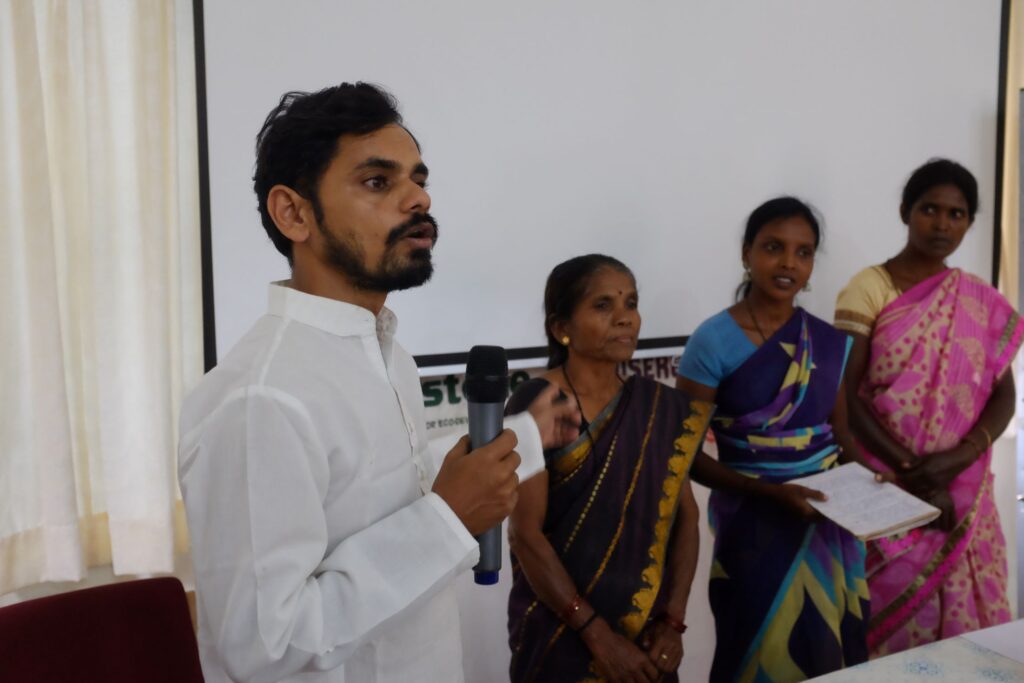
Food security and sustaining agriculture based livelihoods of Jenu Kuruba tribal community in Preiyapatna, Karnatka
- Started with song by community women from Nagarhole forest – song about the food they eat.
- Started work in relocated area as well
- 700 hh different communities – 5 to 6.
- Honey collection and harvesting is the traditional occupation of the Jenu Kuruba
- FRA act implementation is very different in Karnataka and they face challenges due to protected area.
Katkari, Sindudurg – Uday and Rajaram Nikham
- Land rights, forest rights – They are landless and bonded labour. In every season they migrate.
- They are focusing on how to get them Gharthan
29th August 2023
This was a day of field visits. We first went to Maidanhalli to explore Sahaja’s grading farm. Sahaja Samrudha representatives ran all participants through different techniques and methods of seed conservation and seed grading. They explained genetic and physical characteristics or crops and seeds. He emphasised that Seed is called seed if it has got both 1. Physical purity 2. Genetic purity. He also touched upon the challenges posed by cross pollinations and methods to prevent this which included – hand pollination, isolation of plants and Amasculatation (remove male flowers). Individual farmers have to maintain single varieties to stop the cross pollination. He also shared that his experience showed that Desi plants have longer plant life.
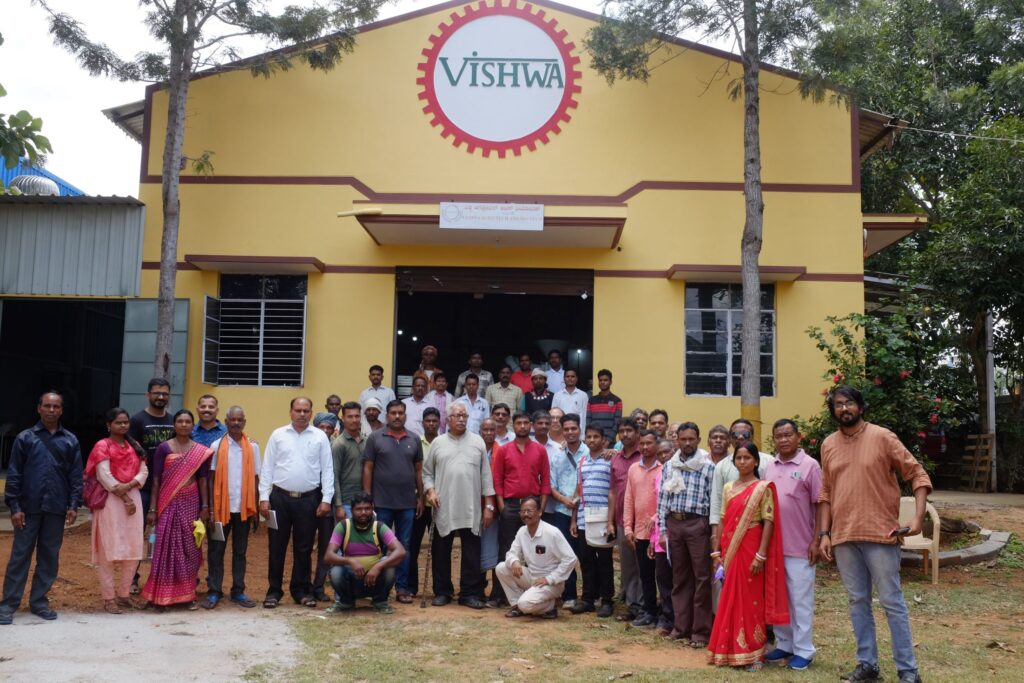
Next we visited Viswa Industries where the owners showed us a variety of machines to carry out different tasks for the processing of various millet varieties which was of particular interest to farmers from areas like Patalkot, Dindori, Anupur, Gariaband and Sundar Pahari who have a long history of cultivating a variety of millets.
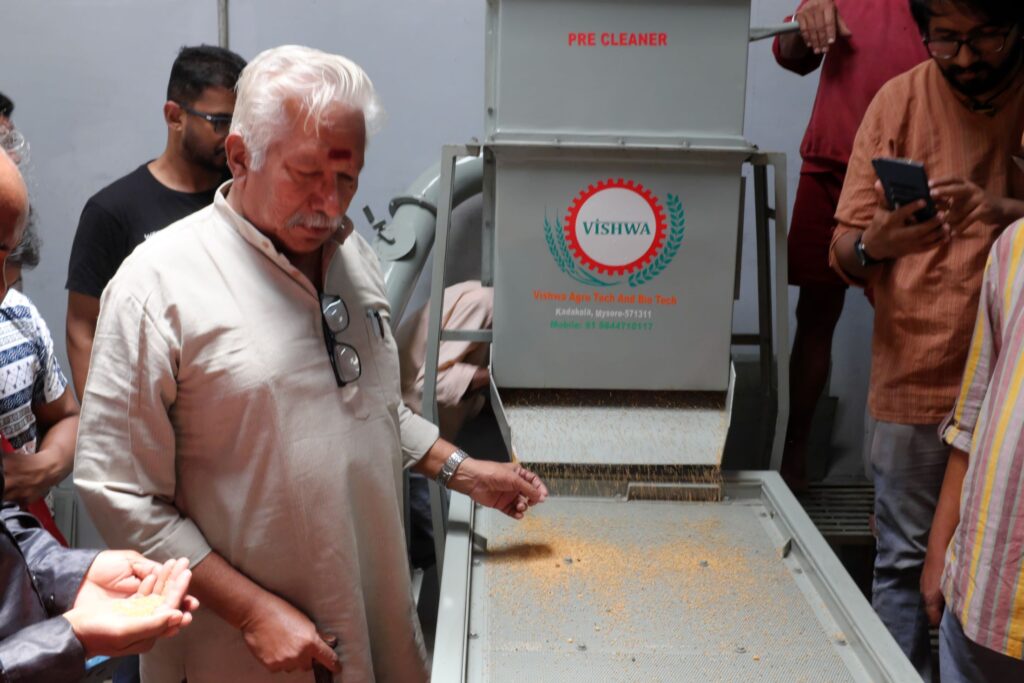
Our final stop was Sahaja seeds which is a Desi seeds producer’s company. The representatives shared that of their shareholders 70 farmers are active and they provide training to their farmers. Shares are priced at Rs. 5000. The participants got to procure a variety of different seeds, especially of vegetable varieties to grow in their farms and homesteads.
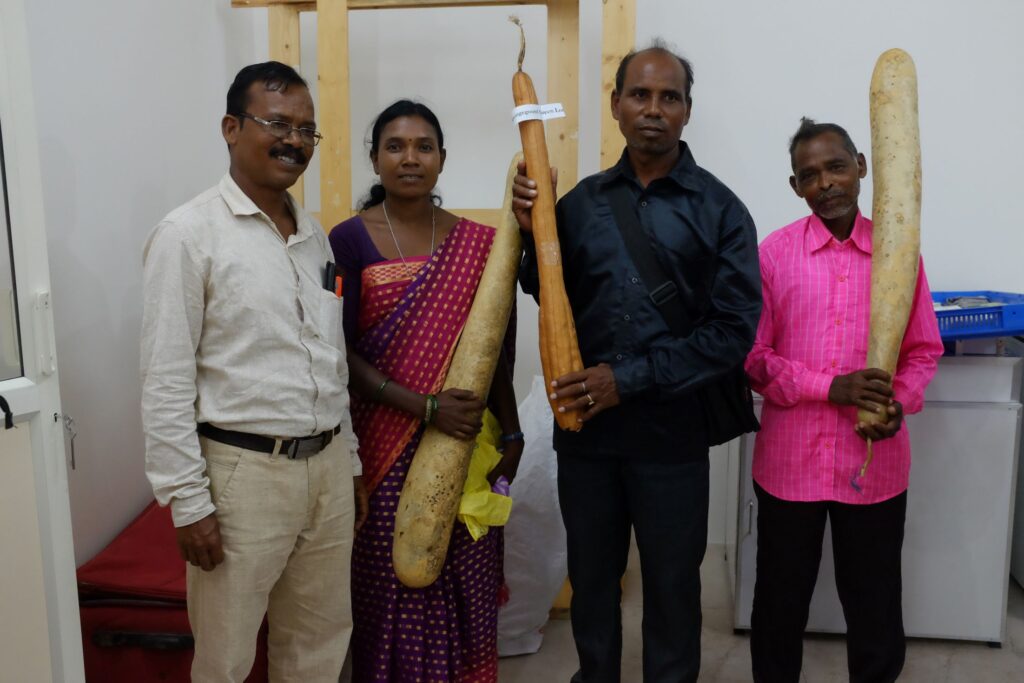
Post Lunch
Sessions started with Onam song by Rakesh
Soumik Banerjee session on Shifting Cultivation –
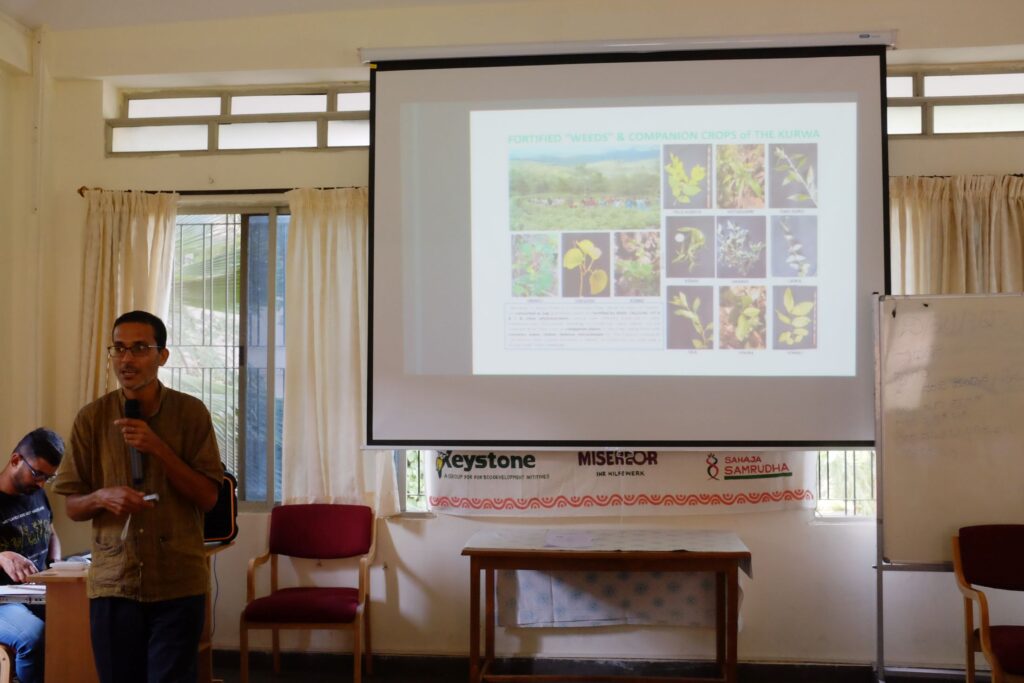
- Studied different types of Shifting cultivation in northern India – bewar, kurwa, podu, paidha, ahaal, jhoom etc.. and rest of India too
- Cultivation means we cultivate for several years and 3-4 times of an year
- Shifting cultivation is old compared to normal cultivation.
- It is a diverse form of cultivation – where we find forests and different types of cultivation.
- We continue cultivating on the same land like the states of Punjab where 4-5 times cultivate on the same land. More chemical inputs are needed.
- No tillage cultivation has become famous these days that is practiced by communities like Baiga and Paharia for thousands of years.
- One of the English offices said that Byga is most terrible enemy of the forests since they practice bewar in those hills where trees were cut for railway needs.
- So many people died in process of railway construction.
- Col. Bloomfield – when famine affected the people in the plains the people in the hills were happy and contented.
- Many reputable institutes worldwide have appreciated the benefits of shifting cultivation.
- Forest does not alone mean trees and animals, but people were also part of it. People and forests have always been coexisted. 6.5 lakh people do shifting-cultivation, millions of hectares of land are shifting cultivated worldwide.
- Paharia refused to move to plains from the hills even though bullets would be fired on them. They never gave up their Kuruva cultivation.
- Damin-I-Koh – land of Paharia approximately around 4000 sqkm awarded to Paharia British after a long period of resistance.
- Though the community practice Kuruva for thousands of years, quality of forests has not been reduced. Bewar have not damaged the forests.
- Comparison of Podu cultivation and reserve forest canopy – not much of change
- Comparison between reserve forests and Podu fallow – not much of difference
- There are a few drawbacks of shifting-cultivations – large area is required for farming.
- But big trees are not felled for the farming – community farming system is practiced in most of the land where shifting cultivation is done. Most of these areas are unreserved. These shifting-farming systems can be called regenerative agriculture.
- Five principles of Regenerative agriculture– no tillage, mix of crops, land cover must be there, perennial roots shall be and there should be domestic animals.
Kuruva, Podu, Bewar are all perfect examples of Regenerative agriculture since it follows all principles of Regenerative agriculture.
- Fortified weeds and companion crops of Kuruva – are more nutritious than the vegetables available from the market.
- Polished rice has nothing to offer but to fill the stomach – Kuruva provides everything that community needs.
- Podu and Kuruva Vs Reserve forests – data shows podu is better in tree populations and food species.
- Trees @ bewar is also as is found in the reserve forests.
- Biodiversity is also rich in Kuruva cultivation areas.
- In Jara method of cultivation, they do not use fire.
- In the system of cultivation, no fertilizers, no irrigation other than rainfed water is used.
- They cultivate cowpea and it is sold often.
- In Kurva method, fire is used in control. They follow mixed farming practices. It is called as unscientific.
- Poppies is new shoots appearing on trees after cutting down as part of Kurva. It is unlike the felling done by Forest Department
- The fallow period was 3 or 4 times in one’s lifetime. We need to think of extending the fallow period to 8 years as the period of fallow is 3-4 years.
- Kurwa- managing invasives – Eupatorium management is effectively done.
- Guided fallow – to control eupatorium, velvet beans are planted, and this species is rich to fix the nitrogen. Turmeric, Ginger, Safed Musli, and taros are planted under the tree. Pepper has been introduced in the area on the trees in the community forest areas.
- Orissa government supported to build contour bunds to prevent erosions.
Rohan – poor of the poor can also practice Bewar since it has no costs involved. Involvement of women need to be addressed. Climate change is affecting the cultivation. People migrate especially youth from the community. There are issues of soil erosion in some of the areas. Fallow period is shortened because of demand for the food and money.
Faisal – What will happen to the un-surveyed forests under forest Conservation act amendment
Sunil – how long will Forest gardens last until the next fallow? It is in an experimental stage, one of the plots is with Surja. Productivity started decreasing after 4 years. Ideally fallow shall be continued up to 8 years. The experiment of forest garden began in the fourth year of the fallow period and sundar Paharia
Post Tea Session
Song by Sidheswar Sardar – “Hum hain garibwa kisan”
Rajeev Khedkar – Private forests in India
In many states there are forest that are privately owned and also forests on revenue land. The FD has been trying to take control of these lands and many such forests have been lost.
Raigarh, Dist, over 1,00,000 ha of private forest. British govt. made section for taking over private forests. They acquired some and some remained with the people. After independence each state made its own rules with regards to this. In some states they did not try to take away private forests but made rules to prevent non-forest activities and ensure that they remain forests. In states like Maharashtra, Kerala and Bihar they took steps to acquire them. In Bihar they renamed Private forests as Private Protected Forest under Forest Officer who could acquire if he feels that these are important forests.
In Maharashtra lot of Private forests, a lot of these forests were acquired by the forest. After much process an amendment was made that only if the PF is more than 30 ha will they acquire and if it is less then they will return acquired PF. But with the Forest conservation act coming in the FD said that they could not return acquired lands.
Saat Barah – record of land deed. PF only described as Workers Jamin (land on hill slopes or land with millets).
No survey on which is Private forest and which is agricultural land.
Goa is the only state that has been trying to survey of Private forests and bring it under record of rights. Started in 1998 but still not completed and in fact they are constantly giving lower numbers from total area of PF.
Change in defination – only if it is adjoining RF forest will they consider it PF and if it is away from RF then only if it is more that 5 ha will they consider it as PF.
- FD says that people over exploit and destroy PF. But this is not true Adivasi have small PF like 1 acre – 2 acre but have protected it well and the forests have good tree cover. Some aeas they cut the trees after 5 to 7 yrs for fuelwood. But they way they cut the trees coppice and forest comes back.
- Privately owned sanctuaries – some PF are being protected as sanctuaries
- Management of Private Forests –
- Working on strategies of planting different tree species and crops that can grow under trees that will help generate income / livelihoods while conserving the trees and forests.

